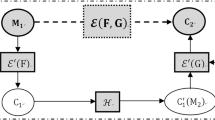Abstract
A bit-oriented quantum public-key encryption scheme is presented. We use Boolean functions as private-key and randomly changed pairs of quantum state and classical string as public-keys. Following the concept of quantum perfect encryption, we prepare the public-key with Hadamard transformation and Pauli transformation. The quantum part of public-keys is various with different classical strings. In contrast to the typical classical public-key scheme, one private-key in our scheme corresponds to an exponential number of public-keys. We investigate attack to the private-key and prove that the public-key is a totally mixed state. So the adversary cannot acquire any information about private-key from measurement of the public-key. Then, the attack to encryption is analyzed. Since the trace distance between two different ciphertexts is zero, the adversary cannot distinguish between the two ciphertext states and also obtains nothing about plaintext and private-key. Thus, we have the conclusion that the proposed scheme is information-theoretically secure under an attack of the private-key and encryption.
Similar content being viewed by others
References
Okamoto, T., Tanaka, K., Uchiyama S.: Quantum public-key cryptosystems. In: Advances in Cryptology-CRYPTO 2000, pp. 147–165 (2000)
Gottesman, D., Chuang, I.: Quantum digital signatures. arXiv:quant-ph/0105032 (2001)
Gottesman D.: Quantum public key cryptography with information-theoretic security. In: Workshop on Classical and Quantum Information Security, pp. 15–18 (2005)
Kawachi, A., Koshiba, T., Nishimura, H., Yamakami, T.: Computational indistinguishability between quantum states and its cryptographic application. In: Advances in Cryptology-EUROCRYPT 2005, pp. 268–284 (2005)
Kawachi, A., Koshiba, T., Nishimura, H., Yamakami, T.: Computational indistinguishability between quantum states and its cryptographic application. J. Cryptol. 25(3), 528–555 (2012)
Kawachi, A., Portmann, C.: On the power of quantum encryption keys. In: Proceedings of Post-Quantum Cryptography, pp. 165–180. Springer Berlin Heidelberg (2008)
Nikolopoulos, G.M.: Applications of single-qubit rotations in quantum public-key cryptography. Phys. Rev. A 77(3), 032348 (2008)
Nikolopoulos, G.M.: Deterministic quantum-public-key encryption: forward search attack and randomization. Phys. Rev. A 79(4), 042327 (2009)
Seyfarth, U., Nikolopoulos, G.M., Alber, G.: Symmetries and security of a quantum-public-key encryption based on single-qubit rotations. Phys. Rev. A 85(2), 022342 (2012)
Fujita, H.: Quantum McEliece public-key cryptosystem. Quantum Inf. Comput. 12(3–4), 181–202 (2012)
Yang, L.: A public-key cryptosystem for quantum message transmission. In: Proceedings of the SPIE vol. 5631(1), pp. 233–236 (2005). e-print arXiv:quant-ph/0310076
Yang, L., Liang, M., Li, B., Hu, L., Feng, D.G.: Quantum public-key cryptosystems based on induced trapdoor one-way transformations. arXiv:1012.5249 (2010)
Boykin, P.O., Roychowdhury, V.: Optimal encryption of quantum bits. Phys. Rev. A 67(4), 042317 (2003)
Boykin, P.O.: Information security and quantum mechanics: Security of quantum protocols. Dissertation for the Doctoral Degree, University of California, Los Angeles (2002)
Ambainis A., Mosca M., Tapp, A., De Wolf R.: Private quantum channels. In: 2013 IEEE 54th Symposium on Foundations of Computer Science, IEEE Computer Society, pp. 547 (2008)
Goldreich, O.: Foundations of Cryptography: Volume 2, Basic Applications. Cambridge University Press, Cambridge (2004)
Yang, L., Xiang, C., Li, B.: Qubit-string-based bit commitment protocols with physical security. arXiv:1011.5099 (2010)
Pan, J.Y., Yang, L.: Quantum public-key encryption with information theoretic security. arXiv:1006.0354 (2010)
Menezes, A.J., Van Oorschot, P.C., Vanstone, S.A.: Handbook of Applied Cryptography. CRC Press, Boca Raton (1996)
Wu, C.M., Yang, L.: Interactive identification protocol based on a quantum public-key cryptosystem. In: Proceedings of SPIE Quantum and Nonlinear Optics III, 926911. SPIE-Int Soc Optical Engineering, Bellingham (2014)
Acknowledgments
This study was supported by the National Natural Science Foundation of China under Grant No. 61173157.
Author information
Authors and Affiliations
Corresponding author
Rights and permissions
About this article
Cite this article
Wu, C., Yang, L. Bit-oriented quantum public-key encryption based on quantum perfect encryption. Quantum Inf Process 15, 3285–3300 (2016). https://doi.org/10.1007/s11128-016-1339-3
Received:
Accepted:
Published:
Issue Date:
DOI: https://doi.org/10.1007/s11128-016-1339-3




